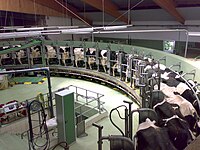
Photo from wikipedia
Animal welfare assessments were conducted on 50 Australian pasture-based dairy farms of varying herd sizes: 16 small (6% integument lesions. Heat stress is an important welfare risk in Australia. All… Click to show full abstract
Animal welfare assessments were conducted on 50 Australian pasture-based dairy farms of varying herd sizes: 16 small (<300 cows), 15 medium-sized (300-500 cows), 11 large (501-750 cows), and 10 very large (751+ cows). A protocol based on elements of Welfare Quality adapted for Australian conditions was developed to assess the broad categories of good feeding, housing, health, and appropriate behavior. Farm records, body condition scores, integument injuries, fecal plaques, avoidance distance of humans, and fecal pat scoring for acidosis assessment were undertaken. The mean maximum kilograms of grain fed per day significantly increased with herd size, from 5.2 ± 0.38 (small), 7.7 ± 0.29 (medium-sized), 8.8 ± 0.45 (large), to 10.1 ± 0.80 kg (very large). Acidosis was not related to herd size based on either farm records or fecal pat scoring. All cows had access to water for more than 12 h in a 24-h period. More larger farms had water points on the farm tracks or at the dairy. Very large farms (90%) were more likely than others (36-39%) to provide water suitable for human consumption. Integument lesions were not related to herd size and were uncommon; 56 and 84% of farms had no cows with lesions or hairless areas, respectively, and no farm had >6% integument lesions. Heat stress is an important welfare risk in Australia. All farms had some form of cooling strategy; shade in all paddocks was more common on smaller farms (>90%) than others (<75%). Sprinklers were more common on large or very large farms (>80%) than others (<65%). Mastitis and lameness were the most common health conditions, followed by dystocia, downer cows, and gastrointestinal diseases. Prevalence of lameness, mastitis, downer cows, dystocia, and gastrointestinal disease were not related to farm size. Larger farms were more likely to have electronic infrastructure to monitor or electronically draft cows for inspection. We found wide variation in the avoidance distance of humans, but this was not related to farm size. Larger farms had longer walking distances to pasture and longer time away from pasture, which could affect the time available for behaviors such as lying down. Animal welfare risks differ on Australian farms compared with housed cattle. As animal welfare is multidimensional, both animal- and resource-based indicators can be useful. Animal-based indicators have strengths in that, when measured accurately, they genuinely reflect the outcome being measured, but they also have weaknesses in that the point-estimate of a disease prevalence on a given day may not be representative of other times of year or differences in case definition may exist when farm records are used. Similarly, resource-based indicators have strengths in that they may be applicable to longer periods, but weaknesses because the fact a resource is present does not guarantee it is being used. Identifying the major risks to animal welfare on individual farms and ensuring a plan is in place to effectively manage them should be an important element of any on-farm animal welfare assessment protocol.
Journal Title: Journal of dairy science
Year Published: 2019
Link to full text (if available)
Share on Social Media: Sign Up to like & get
recommendations!